

Gyeongju,
Where Past Meets Present
Donggung Palace, Wolji Pond & Bomun Tourist Complex
Gyeongju is a world-class city of cultural heritage, home to one of the three heritage sites in East Asia selected by UNESCO in 1979. Some Germans who visited Korea on the TV program “Welcome, First Time in Korea?” also made it a point to visit the city, reflecting its long-held status as a window onto Korean heritage and traditions. Certainly, Gyeongju’s long history is a point of intrigue for tourists. With a range of new tourist activities in Gyeongju, now is the best time to visit. Adding a touch of modern novelty to the rich history and heritage, let’s check out an updated travel itinerary for Gyeongju. You will find a drone video as you read this article. Discover the unique charm about the travel destination as you watch the video!
Written by Lee Seol-hwi, Travel writer Photographed by Studio Kenn
Illustrated by Hagogo

History of Korean Music Under One Roof,
the K-pop Museum
The K-pop Museum in Gyeongju was recently featured in a popular TV trivia show called the “Encyclopedia of Useless but Fascinating Trivia” (Alsseulsinjab,알쓸신잡). The museum is unique among its peers in Gyeongju, being dedicated to the contemporary history of Korean music, rather than to ancient artifacts. A visit to the museum offers a modern twist to this city of ancient heritage.
The K-pop Museum, located at the Bomun Tourist Complex, is Korea’s first museum dedicated solely to modern-day pop music. It provides an overview of the 100-year history of modern Korean music, and offers insight into the roots of the growing popularity of Korean pop music, soundtracks, TV shows and movies in East Asia and elsewhere. It comprises of 3 floors, each 1,091 square meters in area, with exhibits including a soundtrack exhibition, a showcase about Lee Geum-hee, Korea’s first singer of dance music, special halls dedicated to Shin Jung-hyun and Han Dae-su, both legends of Korean rock music, a “100 Greatest” exhibition about K-pop albums, and the first Korean musical record. It also houses many special exhibitions about key albums in the 100-year history of Korean pop music.
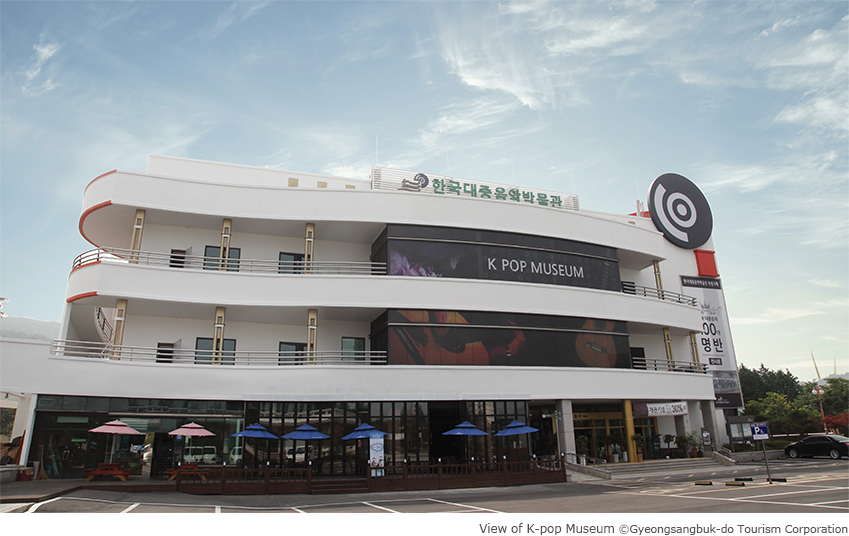
Other than the history of Korean pop music, there’s also a room where visitors can listen to music using a wide range of audio systems, from that used in the first talking films in the 1920s through to nostalgic retro devices, such as cassettes and Sony Walkmans, to the most prestigious high fidelity systems available in the world today.
More than anything, this museum seems like a bridge between generations for those who want to communicate through the language of modern pop music. From bygone melodies loved by our parents and grandparents, to the latest hits taking the world by storm under the name of K-pop, the music in this museum invokes stories and memories to share across the generations.
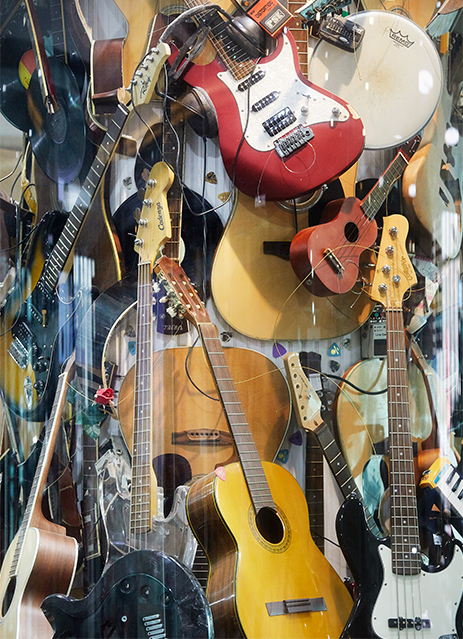
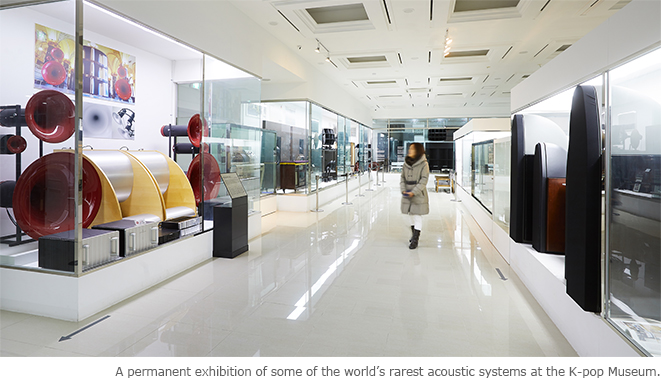
The maritime Vasa Museum in Stockholm is a well-known historical site. It stands next to the interactive exhibition “ABBA: The Museum”, dedicated to the international pop sensation Abba. A museum dedicated to a famous pop group is interesting not only to fans, but also to ordinary tourists. It's an accessible and interesting approach to the arts.
A Japanese visitor to the K-pop Museum exclaimed, “I never knew that K-pop had a history of 100 years until I visited the museum today. It was meaningful to learn that Korean pop music, which I thought was just a fad, had such a long history.”
Just as “ABBA: The Museum” has become a popular destination among tourists from around the world, so, perhaps, the K-pop Museum should be included in your travel plans.

K-pop Special Exhibitions
100-year history of Korean pop music
The 100-Year History of Korean Pop Music is a permanent exhibition that has on display records and artifacts from 1907 to the present, all selected for their historical meaning and rarity. These rare albums and artifacts represent their eras and have been made accessible to the public to show the role that popular music has had on the history of modern Korea, as well as on the evolution of that music over the decades.
Korea’s first cylinder phonograph
LP records and their fabrication process
One of the key contents of the K-pop Museum, this exhibit educates viewers about the production of vinyl music records and their evolution over time.
Soundtrack Exhibition
The entrance to the Soundtrack Exhibition is lined with movie posters that evoke pieces of music that were scored for them. It provides an overview of the most important soundtrack albums in the history of Korean movies, from “Nakhwayusu”(낙화유수), Korea’s first pop record, produced in 1929, to the latest hits.
100 Greatest K-pop Albums
This exhibition comprises of 100 of the most definitive Korean pop albums, as selected by the K-pop Museum’s 15-member advisory committee, as well as music critics, professors and experts. A special exhibition of these 100 albums as selected by the K-pop Museum is also being planned.
Special Exhibition
The costumes and instruments worn and used by the late Lee Geum-hee, Jang Mi-hwa, Hyeon Sook, Lee Hyeon, Jang Uk-jo, guitarist Kim Do-gyun of the band Baekdusan, guitarist Kim Tae-young of Boohwal, Nam Jin, Han Dae-su and others are on display here. Special items include the outfit worn by Yoon Bok-hee in her signature role of “Peter Pan”, Sinawi vocalist Kim Bada’s original LP record, and the outfit worn by Clon’s Kang Won-rae at the time of his accident.
Moonlight Walk Along Bomunho Lake
On the 15th of each month, an atmospheric nighttime walk takes place in Bomun, in Gyeongju. This is none other than the Moonlit Walk Along Bomunho Lake. The walk takes place over a 5-km/ 3.1-mile course along the lakeside, beginning at the Bomunho Lake Plaza, passing by the Bomun Outdoor Performance Stage, over the Mulneoul-gyo Bridge, and returning to the Bomunho Outdoor Performance Stage. The neatly organized pathway continues along the circumference of the lake, making it convenient even for families with children. Adding to the fun are various missions that await walkers at each spot along the pathway.
Facilities such as viewing platforms and foot bridges have been installed along the path to add interest, while wind- and solar-powered street lamps and lighting units present a diverse range of eye-catching sights around Bomunho Lake. Take in the beauty of nature and walk freely, enjoying the uplifting effect on your spirit.
True to its name, the pale glow of the moon follows your every step, allowing you to cast aside the worries of tomorrow. It's a place to which one can turn when in need of rest. Time seems to slow down here somehow, amid the carefree atmosphere filled with romance and memories.
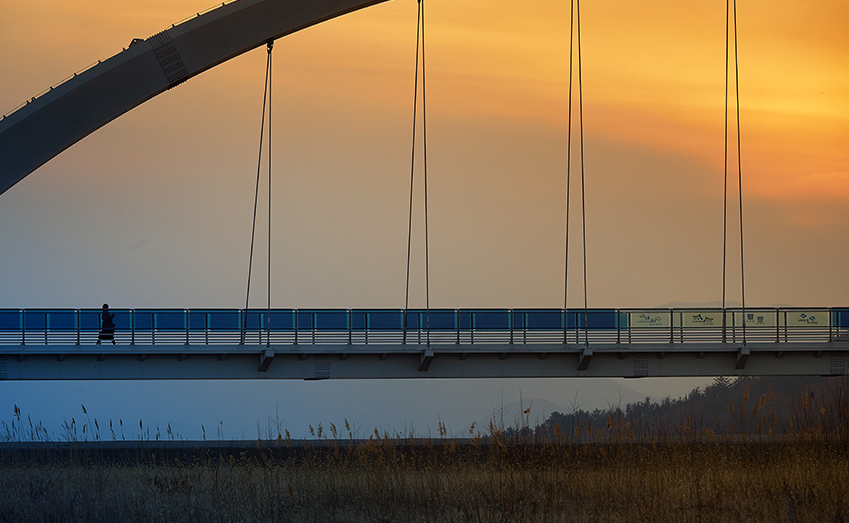
Trip Points
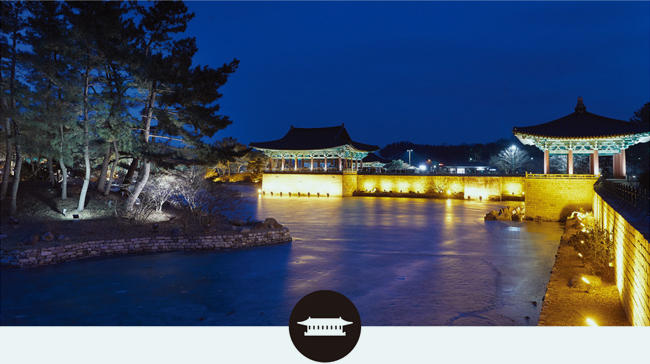
Shilla Garden at Donggung Palace, Wolji Pond
The Donggung Palace and Wolji Pond are the site of a royal villa from Shilla (57 B.C. - A.D. 935), representative of gardens and ponds from that period. According to records, the pond was dug and hills were built in the 14th year of the reign of King Munmu (r. 661-681) to house exotic birds and strange beasts. According to the "History of the Three Kingdoms" (Samguk Sagi, 삼국사기, 三國史記), compiled in 1145, a party was held there in 931 hosted by Shilla King Gyeongsun (r. 927-935) in honor of the Goryeo founder King Taejo (r. 918-943), showing that the palace was used to host banquets for foreign officials and to entertain important guests. These banquets were usually held around March or September, when the area’s natural beauty was at its peak. While Wolji Pond in daylight is tranquil and peaceful, it comes to life with bright lighting at night, offering visitors a dazzling night view. Visitors are also recommended to take the 10 minute walk from the Wolji Pond to the Cheomseongdae, which is yet another impressive night spot that adds to the beauty of Gyeongju.
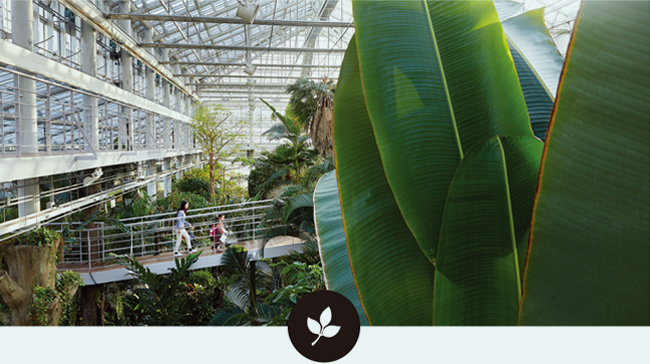
Donggungwon Garden, a Reinterpretation of History
The Donggungwon Garden is a modern reproduction of the Donggung Palace and the Wolji Pond, based on records from the "History of the Three Kingdoms". They state that exotic birds and beasts were raised at the palace and near the pond. The records also provide information about historical occurrences unique to the city of Gyeongju. The Donggungwon Garden stretches over an area of 2,353 square meters/ 25,327 square feet, and its modern reinterpretation of history begins with its architecture, with buildings that were inspired by the ancient Shilla styles. The Donggungwon Garden is organized into a coconut garden, a foliage garden, a flower garden, an aquatic garden and a tropical garden. It comprises of over 5,500 specimens and 400 species of plants. Historical touches, such as the Cheonmado sculpture, streams, the Jaemaejeong Pavillion and the Wolji Pond's boat, enhance the experience of a recreated Shilla garden. A 7-meter/ 23-foot viewing path overhead passes through a cave with a waterfall. Above all, the garden offers visitors a respite from the fatigue of sightseeing, as they take deep breaths of the refreshing forest air.
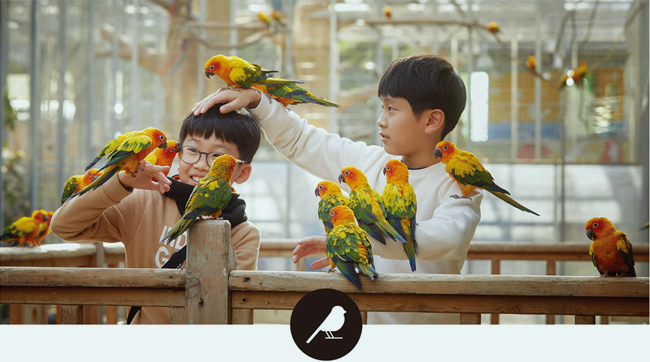
Look, Touch and Experience the Bird Park
True to its name, the facility is home to an eye-opening range of birds. Moreover, the park is Korea’s first hands-on bird park, meaning that the birds are not shut away in cages, but fly freely within a large aviary. They can sit on visitors’ shoulders and interact with people directly. Ninety percent of the animal species here are birds, while the rest includes reptiles, fish and assorted small animals. Internal facilities include the Ecological Experience Hall and Experiential Exhibition Hall, while the outdoor area has a petting zoo with ostriches, ponies, turkeys and peacocks. The park is popular with children, as they can touch and play with the birds, all while learning about nature and satisfying their curiosity.

Beauty of the Seasons at Bomunjeong Pavilion
Bomun Park is well-known for its beautiful cherry blossoms that draw crowds of tourists and photographers every year. It's a great place for a walk among the flora with friends, families or a date. The Bomunjeong Pavilion, located on a small lake at the Bomun Tourist Complex, is noted for its outstanding beauty and is ranked 11th on CNN’s list of “50 beautiful places to visit in Korea”. The beauty of the pond is present all year round, with cherry blossoms in the spring, lotus flowers in the summer and autumn colors in the fall. In the winter, a luxurious layer of white snow covers the water, making for an unforgettable scene of tranquility.

Travel Tip
-
Gyeongbuk Tourism Publicity Office
Tel. +82-54-745-0753Registration Instruction
At the Bomun Tourist Complex in Sinpyeong-dong, Gyeongju,
Gyeongsangbuk-do ProvinceTravel Hotline
Dial 1-330, with no prefix or area code. It's open 24-hours, all year-round.
Travel information and interpretation services is available in Korean, English, Japanese and Mandarin.Tour Information Desks
- +82-54-745-0753
Gyeongbuk Tourism Publicity Office (Bomun Tourist Complex)
- +82-54-772-3843
Gyeongju Station Tourist Information Office
-
- +82.54-771-1336
Singyeongju Station (KTX) Tourist Information Office
- +82.54-777-1330
Seorabeol Tourism Information Center (Gyeongju Interchange)
- +82.54-779-6079
Gyeongju Cultural Tourism Guides
- +82.54-772-4041
Donggung Palace and Wolji Pond
Operating Hours
9 a.m. to 6 p.m.
Tips for Visitors
Donggung Palace and Wolji Pond
Visitors arriving too close to the closing time may not be allowed in due to the large numbers of tourists coming to see the night views.
-
- Opening hours / 9 a.m. to 10 p.m., all year round
Tour guides in foreign languages are available
- Available hours
Off-peak season / 9:30 a.m. to 5 p.m.
Peak season / 9:30 a.m. to 5:30 p.m.Donggung Palace Garden
Present your ticket to the Donggung Palace and Wolji Pond, or to the Daereungwon Tomb Complex to get discounts for the Donggung Palace Garden and combined tickets.
- +Opening hours /9:30 a.m to 7 p.m.
- +Last entry at 6 p.m.
- +The musical fountains are in operation from 10 a.m. to 6:30 p.m.
Other Articles


K-pop tomorrow

Sharing the Spotlight

Where Past Meets Present

para ice hockey player

well-designed things

Smart Technology, Services

Korea’s Take on Chicken


in Hong Kong
Application of subscription
Sign upThe event winners
Go


 March 2018
March 2018




